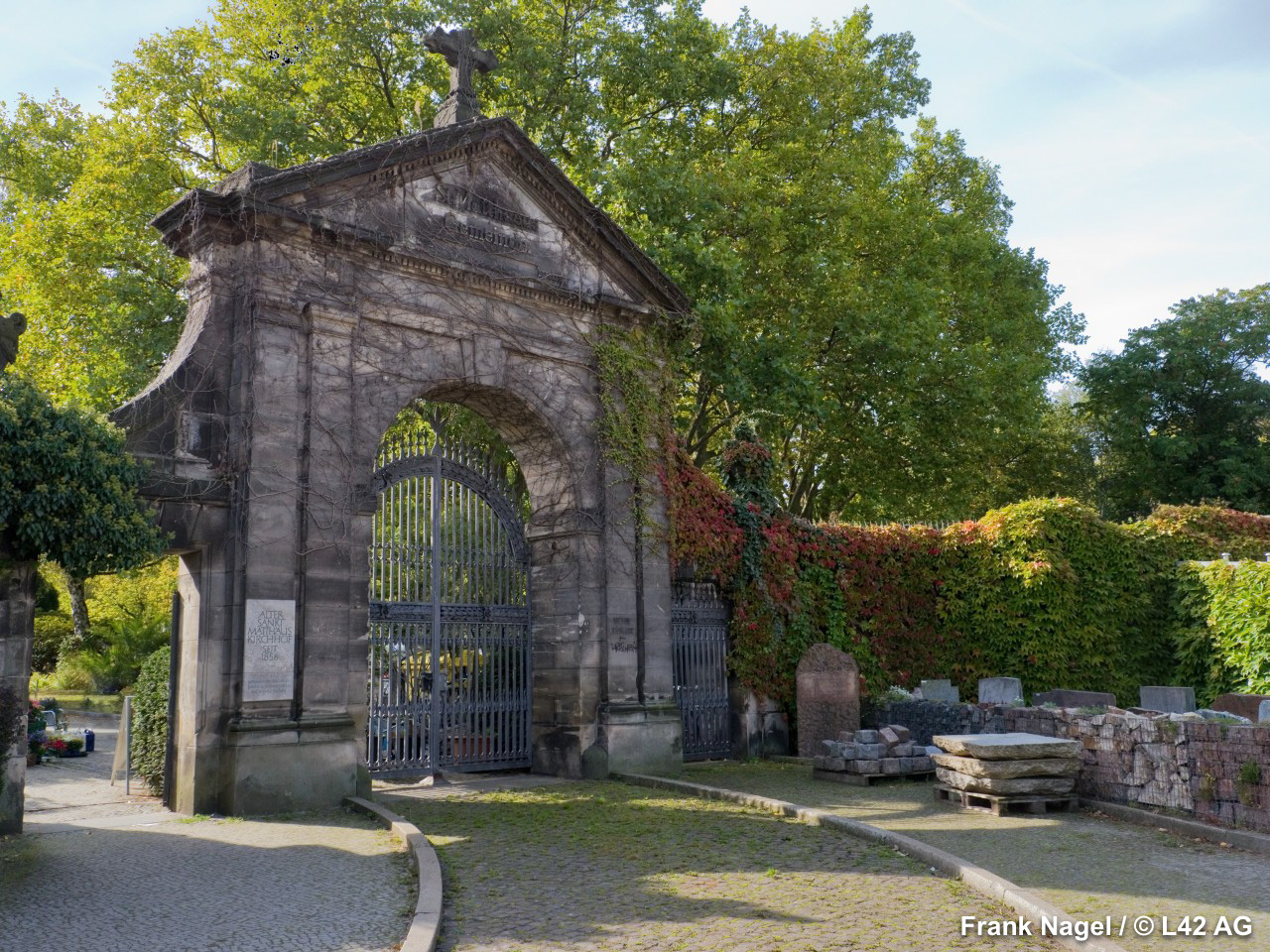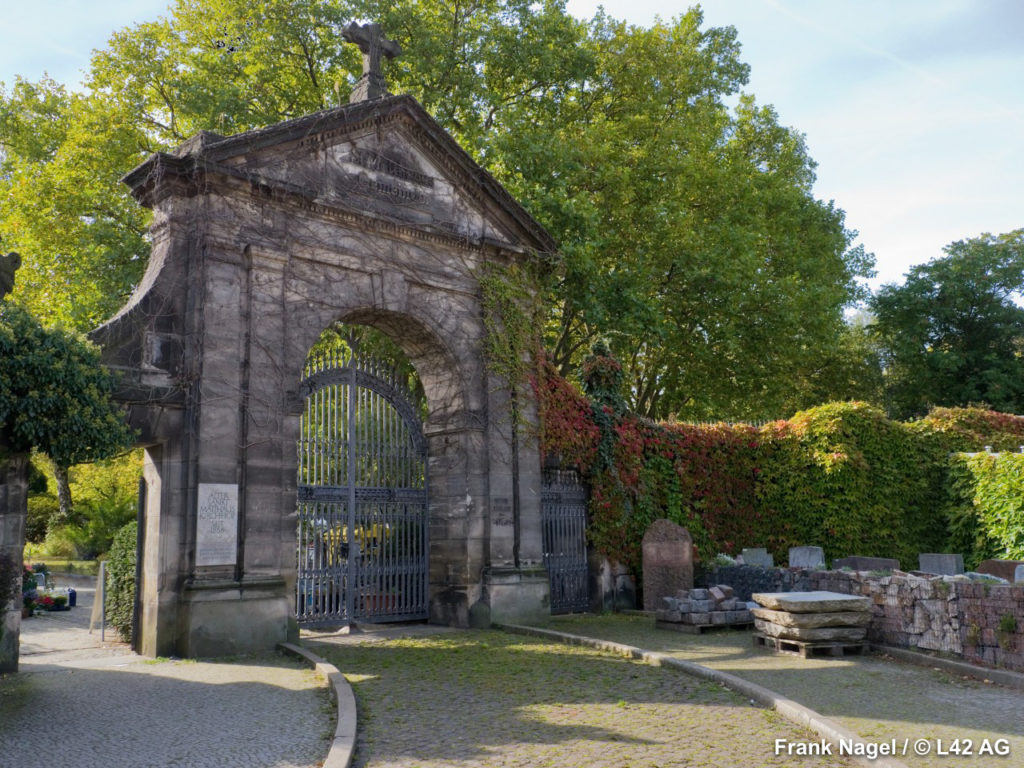
A monumental stone gate with a cross split in the center and two urns to each side lead into the cemetery of St. Matthew. A “cemetery” in German is referred to as either “Friedhof” – yard of peace – or “Kirchof” – churchyard. That of St. Matthew was created in 1856, ten years after the foundation of the parish of the same name which is a few kilometers away. The cemetery is therefore more than one hundred fifty years old. It isn’t the oldest in the city, but it is certainly among the most attractive and important.
The community of St. Matthew was once primarily made up of the bourgeoisie, some even rather powerful, and therefore its cemetery was well taken care of from the very beginning. In 1938 it came under threat from Albert Speer’s plan for the city which foresaw the destruction of the northern end of the cemetery to make way for the great north-south axis of the new capital of the Reich. Then, as we have already learned, the war, thankfully, made his plans come to naught. St. Matthew has thus remained one of the few points of bourgeois continuity between the Berlin of the 19th and 20th centuries. The mausoleums that you can still find today give you an idea of this opulence. A walk through this place of peace is a special trip through the history of our city and quietly and directly introduces us to a certain spirit that is difficult to find elsewhere.
Most of us, if it were at all possible, would likely avoid the subject of death indefinitely. The culture of the north, however, is more inclined to confront absence, pain, and mourning. You only need to think of the sagas and ancient legends in order to arrive at the romantic anguish surrounding the impossibility of satisfaction, whatever type it might be. In German we find the word “Sehnsucht”, which in English is usually translated “yearning” or “longing” but which to the German soul means a whole lot more. It is the vital tension which brings one to desire that which cannot be had and could be argued to represent the emotional impulse to the maximum degree. At this point you could open up a century-long parenthesis, but this could seem only an excuse to no have to confront the greater subject at hand.
Now, a visit to the actual cemetery of St. Matthew in Berlin will not turn all of you into German romantic poets, but it is a walk which, in any event, is good for your health, if anything simply because it is a rather green and artistic space, not to mention its smooth and cardiovascularly beneficial slopes.
Welcoming an unwilling tourist from southern Europe – superstitiously grabbing hold of their crotches maybe – immediately inside the front gate is the picturesque café Finovo, whose name is supposed to be an exotic contraction of the words “fine” (“end/ending”) and “nuovo” (“new”). Between Finovo and the gate there is the barista’s little workshop who also sells flowers and the precious and complete guide to the cemetery, the work of Hans-Jürgen Mende.
A pleasant series of books, apps and illustrated maps on the cemetery recently appeared and are a great accompaniment to any first-time reconnaissance mission. Having said that, the best of all the possible guides, of course, whether technological or paper, remains a poet.
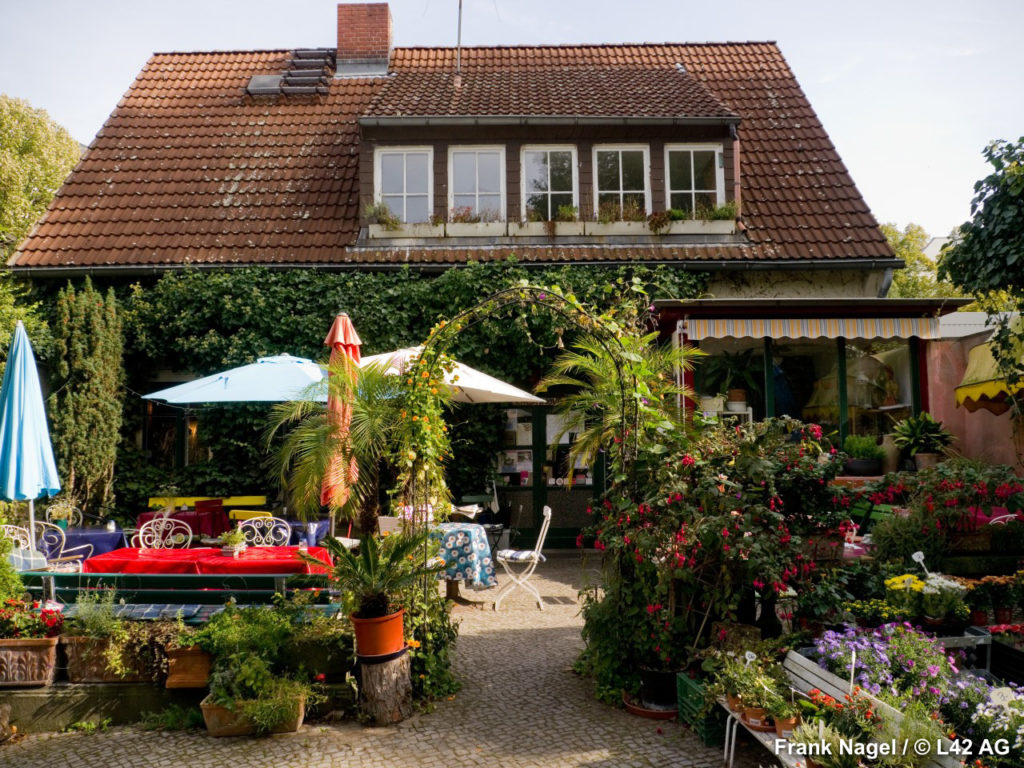
In spring and summer you can sit at the little white wrought iron tables out front in the garden, drink a coffee, and eat a little piece of homemade cake while looking out over the fuchsia, begonias, wild roses, thujas, trumpet flowers, verbena, poppies, bindweed, alyssum, lampranthus, and field roses, but also the exotic oleander, charming palmettos, and the ivy cascading down the 19th century gate and surrounding walls. It is hard to imagine a more tranquil and welcoming place. It is literally an affectionate and comforting embrace. The poet has always known this, of course, and smiles like a contented child every time.
The trains pass by here, as they do all over Berlin, to remind us that we are in the capital of Germany, lest we imagine we are somewhere else entirely, who knows, even thinking any minute we might encounter Miss Marple. In any case, the trains are those of the S-Bahn, and, to be exact, those of the S1 which pass between Berlin and Potsdam and Wannsee, to the southeast, and to Oranienburg at the extreme north, and vice versa. When the vegetation is blooming, you only manage to see the beige stripe of their roofs and the red just above the windows. You hear the clatter and then the two colored stripes, sometimes in one direction, sometimes in the other. Apart from these passing stripes, the sparrows pecking at the entrance gate bell with their beaks, the peal of bicycle bell, and the regular sawing of the mason in between the gate and the rails, the quiet is all encompassing.
In winter the trees are grey, the trains are in full view, instead of the colored flowers they sell wreaths of fir and spruce, and the sparrows are pecking at the snow.
There are always a lot of people passing by the cemetery gate, and every one of them gives a “hello” toward the café and walks on. There are gardeners, brick layers, habitual visitors and volunteers who help with the care of the tombs. In spite of being a place for eternal rest, there is an unusual amount of activity. It is not by any means a gloomy or unsettling place, this limbo between the earthly and otherworldly, immanence and spirit, no less agreeable than certain artificial paradises certainly.
If it weren’t for the pulsations, the rhythms, and inescapable timed cadences of the trains, this would without any doubt be a surreal enclave blissfully indifferent to time.
The poet takes a breath, holds it for a moment, and then breathes out in German: “Die Scheidung zwischen Vergangenheit, Gegenwart und Zukunft
[hat] nur die Bedeutung einer, wenn auch hartnäckigen Illusion.”
From what hereafter did he manage to get this quote holding that the division between past, present, and future is nothing but a stubbornly persistent illusion? Doubtless from some spineless colleague from the insane era that was known as the romantic!
He wags his finger “no.” Albert Einstein. 1955.
When it’s winter you can drink your coffee inside Finovo’s little front room. Five tables all in different styles and materials, seats and benches more mismatched than you thought possible, and artistically-made lamps of different paper for each individual table. Proud of their lives led laid-back candleholders and sugar bowls of the most incredible shapes decorate the tables on linen and lace doilies. On the yellow walls among pictures of flowers and the flights of swallows there are five different clocks rigorously displaying five different times, crosses and Madonnas, mirrors, angels, and two photos of beautiful young women.
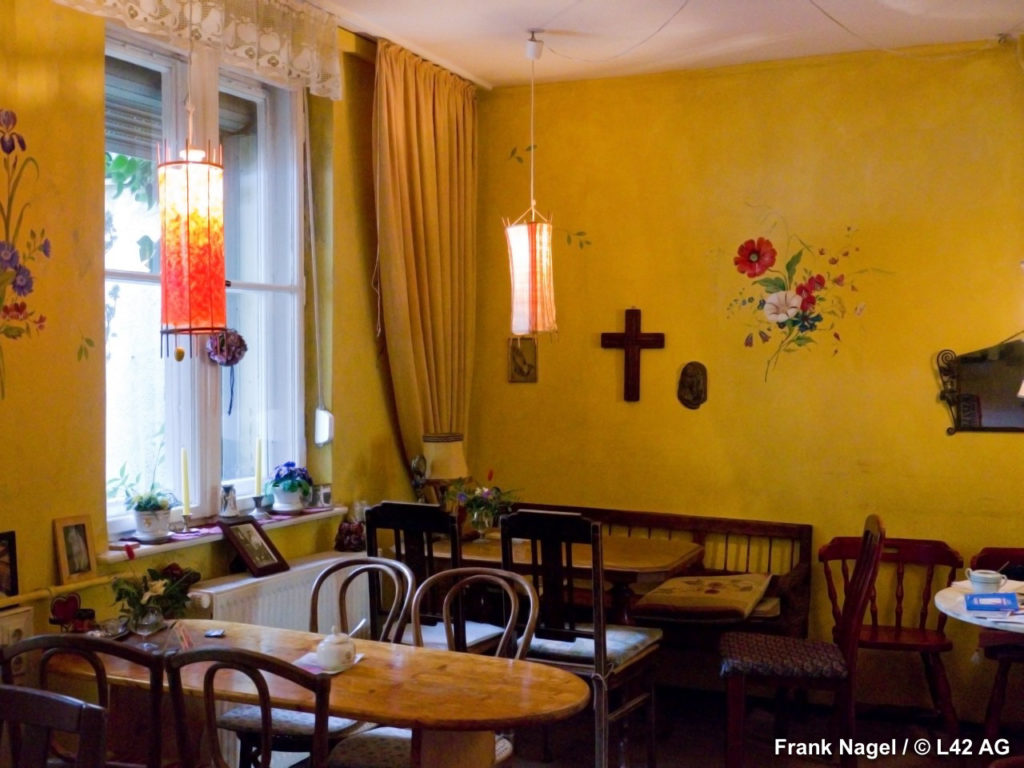
The poet remains enchanted by these. On the windowsills of the two windows which look out onto the garden are lazing old objects like a candy pink crocheted tea cozy and little framed photographs of dogs and cats. An electric heater shaped like a fireplace balances a shelf with a little library with titles like The Truth about Hänsel and Gretel; Death Is a Gift; My Religion, Your Religion; Mourning; Death Belongs to Me; Blues in Black and White; Luther; Lively Grieving; The Grimm Brothers’ Most Beautiful Fables; Crying Makes you Thirsty; Little Red Riding Hood; Always Ready!; Memento Mori; Cemeteries of Europe; The Garden of Melancholy; Fifty Angels for the Soul; and so on…The title Crying Makes You Thirsty is curious. We have a look and see that it’s an illustrated children’s book telling the story of how little Joris confronts the death of his uncle Hugo. We leaf through another rather amusing book which is a collection of unusual death announcements: “Your journey ends here,” and next to it the picture of a train, “unfortunately we have to get off. We would have liked to have continued onward with you, but you’ve already reached your destination.” And then, in a German culture obsessed with meetings, we read: “Attention! Stefan B.’s next appointment has been postponed for personal reasons to a later date.” Or, for a friend, the classic: “You were always late, but now you have gone too soon!”
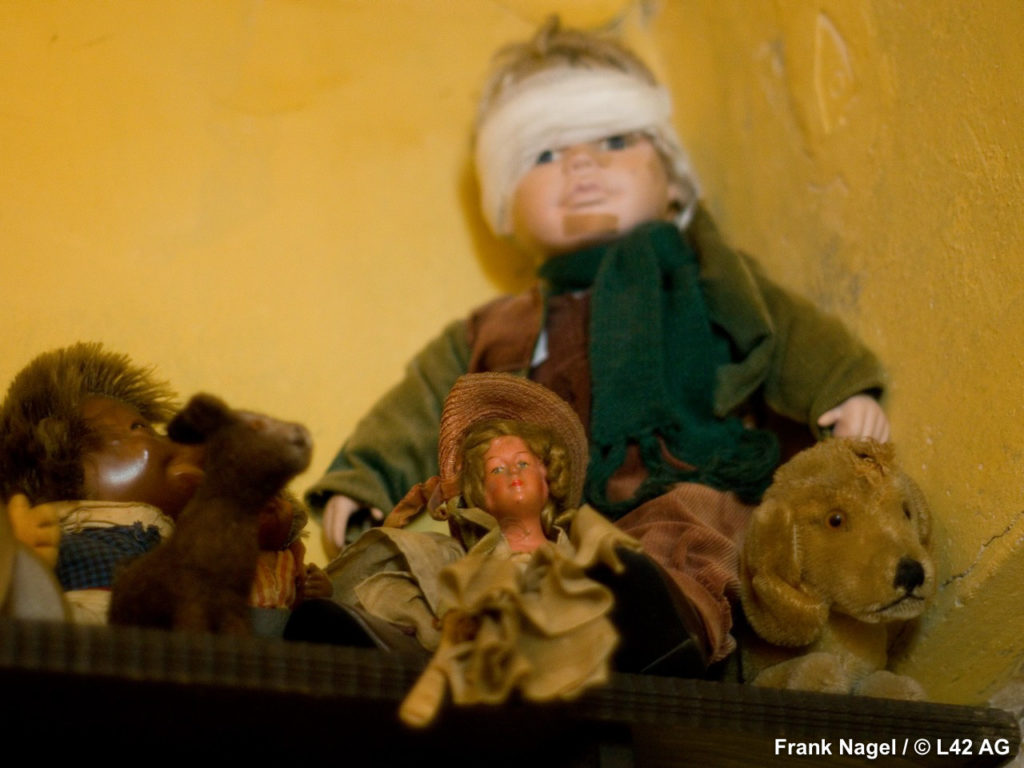
In a corner behind the front door there is a colored wooden doll’s cradle welcomes children’s toys while on the hat rack above it a group of miscellaneous stuffed animals sits in a row. A doll with a bandaged face reminds us of those photos of soldiers in field hospitals from the First World War. Next to her is a stuffed bear and, on her other side, two laughing porcupines, who knows why. Next to them there is a rather self-absorbed little dog, and then a puppet with a checkered shirt, extremely long legs dangling over the sides and only one shoe.
We’re not really sure how one’s supposed to confront a cemetery, but before even getting the question to our lips the poet signals to us with his hand to slow down, like he was a traffic officer. The care with which the cemetery is treated makes this walk anything but sad. There is a serene and relaxing air to the entire space as well as a good amount of Berlin’s art, history, and nature.
You cannot help but immediately notice the neo-classical and Renaissance-inspired church with its rounded arch doors and exquisitely German touch of the large writing above the entrance door – Eingang – and exit door – Ausgang – as if to rationally regulate the coming and going of souls, as if it were something like controlling the crowds in the subway.
We shall take a walk following Hans-Jürgen Mende’s suggestions, but shall offer only a purely arbitrary selection of the tombs.
We picked up an original map of the cemetery and immediately noticed that the cemetery presents itself to the world, naturally, for what it is: a bit rational, a bit cardinal, and a bit of a mess. It is organized into sections, rows, and numbers, somewhat like Venice, but the letters of the alphabet that distinguish the different zones sometimes repeat without any particular apparent motive or mysteriously disappear.but the letters of the alphabet that distinguish the different zones sometimes repeat without any particular motive or even mysteriously disappear.
But all of what would make an everyday postman go insane just makes the poet tremble with delight, in the same way the adventure of a treasure hunt would excite a child. We’ll leave the addresses of the tombs alone–in other words, what you find on the green plates–and won’t bother to assign them any other arbitrary numbers.
Nothing whatsoever, of course, precludes one from choosing their own alternative, instinctive path, and lingering wherever their eyes take them.
The poet no doubt will do so, flitting about like a butterfly, at one point here, at one point there. Every now and again he will sit down on a bench, pull a book from out of his pocket, immerse himself within it, only to hide it away immediately as soon as we approach him. “What are you reading?” we ask him every time. “Nothing, nothing,” he responds every time.
The first walk to be suggested is one which winds along the entire expanse of wall from left to right.
The first tomb we encounter, and one of honor, at H-OE-001, which is in area OH, row OE, number 001, is that of the famous historian Sybel, whose life spanned the 19th century, a man at the center of the literary and artistic life of the city. What’s curious about this monument are the two reliefs in profile of the scholar and his wife.
At Number 9 we find the tomb of the sculptor Streichenberg, also active throughout the 19th century with complex works like that of Antinoo with the serpent in the park of Sanssouci; in contrast, however, his wife’s tomb is extremely straight forward. Throughout the tour one notices again and again how the most monumental tombs of the 19th century seem to have been erected in memory of industrialists and rather powerful men while those to artists and intellectuals, on the contrary, were surprisingly sober affairs. The poet remains enchanted by these three words and for a long time repeats them to himself almost as if they were a mantra. “Surprisingly sober affairs, surprisingly sober affairs, surprisingly sober affairs…” We have no idea if he’s reflecting on the meaning of the words or simply listening to the ring of the English “r”s, like children playing with their first babbles.
At Number 12 we find the beautiful neo-Renaissance tomb honoring the gynecological director of the Charité, Professor Mayer, the son of an even more famous father whose tomb we shall encounter shortly. This monument presents us with a deep niche, bordered by columns, in which there is a sarcophagus upon which sits a protective angel. The niche was designed by Martin Gropius while the angel comes from the sculptor Julius Franz.
At Number I-OE-005 we must reflect on the tragic story of the entrepreneur Strousberg, he too a figure of the middle of the 19th century. From being an anonymous businessman in a short time he became the King of the Railroads, building a good part of the lines across northeastern Europe. He also founded the newspaper Die Post, bought factories, land, and mines and lived the high life until his whole empire came suddenly crashing down due to too many risky investments. At the exact same time his son Arthur died and he hired the sculptor Reinhold Begas – the same sculptor who made the statue of Schiller at Gendarmenmarkt and Bismarck at Große Stern – to complete the mausoleum. Strousberg at that point was engulfed by debt and even his son’s tomb was destined to be impounded. Eight years later his wife died and two years after that it was his turn. And in extreme poverty.
The honor mausoleum K-SE-016 erected for the architect Messel who was active in Berlin at the end of the 19th century is unusual and modern in that it was realized in a Doric style with shelly limestone by his famous student, the architect Paul Baumgarten, who himself was specialized in the design of splendid villas, among which that of Max Liebermann at Wannsee and thereafter elegant theatres throughout the time of the Third Reich which were decorated with Führerloge, in other words, loges for the Führer.
Doctor von Holshausen was one of the most famous gynecologists of the city at the end of the 19th century and was awarded the noble title for his gynecological and obstetrical work. His tomb is to be found at M-SE-001
His neighbor Doctor von Kusserow, on the other hand, whose former tomb of honor M-SE-010 was designed by the architect Martens, was a military doctor who lived between the 18th and 19th centuries. The story of his life brings us back to the paths of noble families of that time who had their sons go to military academies there where they were unable to offer them a normal course of bourgeois studies. Little Karl Friedrich Ferdinand was only five when his law officer father died. His maternal uncle took responsibility for his education in a French gymnasium, where the young boy simultaneously studied medicine and joining the military. From company surgeon over the course of his life he ascended through the ranks of a military career and eventually offered space in his mausoleum to all of the members of his family who more or less followed in his footsteps up until the rather lighter ones of his great grandchild Hans, who was born in 1911 and died in 2001, the primo ballerino and then choreographer of the Deutsche Staatsoper.
From the lovely and almost ethereal steps of Hans von Kusserow we arrive at the rather concrete ones of the energetic Mr. Bolle, memorialized in tomb P-SE-012, which also closes the southwestern corner of the cemetery. He began his career as a bricklayer, then became a contractor, then an ice producer, and, as a result, a fish merchant up until 1881 when three of his coaches began to make the rounds of Berlin selling up to 1,500 liters (396 gallons) of milk a day. Toward the end of the 1880s there were close to one hundred of these coaches and almost two hundred young men wearing the by-then famous blue Bolle uniform selling up to 40,000 liters of milk a day. Mr. Bolle therefore began to raise cows, as well as to distribute fruit and vegetables, honey, and fresh eggs. He took extreme pride in the quality of his products. Bolle’s slogan – the majority of which at that time were by no means close to the industry they are today – ran simply as follows: “Urahne, Großmutter, Mutter und Kind von Bolles Spezialitäten begeistert sind.” In English “Ancestors, grandmothers, mothers, and kiddies are all impressed by Bolle’s spec-i-al-i-ties!” Full stop.
At Q-WE-078 we find the redbrick memorial to Ms. Von Neindorff, a dame of the court of the Empress Augusta. The empress died in 1890 and her dame one year later.
The Finnish countess von Nyander, who died in 1905, enjoys an elegant tomb at Number 43 with a large niche and a small garden enclosed by a fine wrought iron fence. The countess did not desire such elegance for herself, but for her young son who passed away prematurely.
And now we suddenly arrive at our own time at tomb Q-WE-042 in memory of notorious homosexual author Napoleon Seyfarth, who died of complications from AIDS. He left us, however, with an autobiography entitled Schweine müssen nackt sein – Ein Leben mit dem Tod, in English Pigs Must Be Naked – A Life Together with Death, a book containing lines like Finis porci, facriminis initium! (The pig’s end is simply the beginning of sausage!) and Lust will Ewigkeit! Tod hat sie! (Pleasure seeks eternity! Death’s got it!).
At this point our poet feels particularly inspired, he spreads his arms to the sky like the Catholic priests used to do at the end of the Latin mass but instead of saying “Oremus!” (“let us pray”) declaims “Wie alles sich zum Ganzen webt, Eins in dem anderen wirkt und lebt! Wie Himmelskräfte auf und niedersteigen (…) Von Himmel durch die Erde dringen, Harmonisch all das All durchklingen!” What’s he going on about? Oh, right, yes, the first part of Goethe’s Faust. “All weaves itself into the whole, / Each living in the other’s soul. / How heaven’s powers climb up and descend…Through sky and earth—their singing / Is ringing through the world.” Let us continue.
The tomb at number 54 remembers the publicist Lipperheide who worked in the world of fashion and costume-design together with his wife Frieda in the time between the 19th and 20th centuries. He was connected to many different fashion magazines in his time, including Bazar and Die Modenwelt, illustrierte Zeitung für Toilette und Handarbeiten, or The World of Fashion: Illustrated Journal for One’s Toilet and Handywork. In addition the two published the Illustrierte Frauenzeitung, that is, The Women’s Illustrated Journal, which from 1912 onward was simply known as Die Dame, The Lady, and which ceased publication in the last war, barely surviving its editors.
Having finished the first round along the boundaries of the cemetery, we’ll prepare ourselves now for the second along its eastern half. First in line is Walterchen of the golden heart, with his low and rough stone A-W-038. Herr Draesel was the proprietor of the dancehall Walterchens Ballhaus in the Bülowstrasse in the lively period between the two wars. When he died his wife Elvira gave the church its bell. Behind Walter at A-SE-067 is the little Grecian temple with a bronze door of the furrier Herpich who also lived between the 19th and 20th centuries and who had stores in London and Paris. Inside his mausoleum is a nice marble statue of a young woman in memory of the Jewish gallerist Linz who died in a concentration camp.
At the far end of the same row at A-SE-0250-A we find the stone honoring the officials who were killed the night of July 20, 1944, after their attempt to assassinate Hitler in the famous Operation Valkyrie failed. Those involved were Count Claus Schenk von Stauffenberg, his lieutenant Werner von Haeften, Colonel General Ludwig von Beck (who in the case of the operation’s success was to have become Reich President and head of the military), Colonel Merz von Quiernheim, and Colonel General Friedrich Olbricht. The officials were tried and executed in the Bendlerstraße which today is called Stauffenbergstraße. Their bodies were then brought to this cemetery, but after only a little while they were exhumed and burned, and their ashes dispersed.
At A-SE-052c we find the tomb of the art historian and writer Franz Theodor Kugler who lived in the first half of the 19th century and is defined as one of the fathers of art history as a modern autonomous science.
Thereafter follow the tombs of a number of businessmen active throughout the second half of the 19th century, like the dark granite Ionic temple at Number 65 in memory of the building magnate Noah, and the classicist limestone tomb at A-SE-036 of Herr Kallenbach, known for his tube and wire factories.
Facing the little avenue at A-SE-012 we find the mausoleum of Ovo Maltine, the pseudonym of the artist, author, and cabarettist Christoph Josten who passed away from complications related to AIDS at the beginning of the 21st century. He was the tireless organizer of events to educate and sensitize the public about this terrible illness. He has left us with the documentary entitled Tunten lügen nicht – Queens Don’t Lie.
Up ahead to the left at H-016-004 lies the tomb of the inventor and pioneer of electrical engineering Friedrich Franz von Hefter-Alteneck, the discoverer of the drum armature for dynamos, the amyl acetate lamp known as the “Hefner candle”. Von Hefner-Alteneck was employed the AEG and by Siemens in the second half of the 19th century. He also was responsible for the Dosenschreiber, a teletypewriter with alphanumeric keys that would generate Morse code. His tomb is still maintained today by Siemens.
Next to the inventor at H-013-009 is a young contemporary of ours, Herr Pindorfer, a tomb in the form of a little space with two bonsai planted at its center and a stone base with the words of Gustav Mahler from “Das Lied von der Erde”: “Das Firmament blaut ewig und die Erde/ Wird lange fest stehen und aufblühn im Lenz / Du aber Mensch wie lange lebst denn du? (Eterno è l’azzurro del firmamento e la terra / rimarrà a lungo immobile e a rifiorire in primavera. / Ma tu, uomo, ancora vivrai?)
The former tomb of honor H-009-022 is dedicated to the memory of the 19th century mathematician Lazarus Fuchs who gave humanity the differential equation that still carries his name.
Next to him at H-007-015 is the seamstress Frau Napora, of whom we know nothing about. However, the Jugendstil statue of the angel in Carrara marble is very attractive. At H-W-051 there is the tomb of the 19th century philologist Müllenhoff, who managed to trace poetry, prose, and old German fables and sagas and passed them on to his contemporaries. Two crosses were erected at H-001-025 for the theologian Fischer and his wife.
Next to them is the homosexual writer, journalist, and painter Reinhardt von der Marwitz, who founded the first gay newspaper in Germany, “Schwuchtel”, and two years later the first openly gay bar Café Anderes Ufer (The Other Shore), which later also became the hangout of artists and musicians like David Bowie.
Back to back with von Marwitz’s tomb is that of another ferryman to the other shore, the father of cellular pathology Rudolf Virchow, who was active in Berlin throughout the 19th century. In fact, you can quite calmly divide the history of medicine into two eras: the pre-Virchowian era and the modern era. In 1800 people were still dying by the millions throughout Europe because of diseases connected to the lack of adequate sanitary systems. Professor Virchow was an extremely important man of science as well as action. He even possessed the titanic strength to go against the Iron Chancellor who did not see the need to provide the city with drainage pipes and thus managed to save thousands of lives. In addition, he had four hospitals opened in Berlin and forced the slaughterhouses into adopting new procedures for the inspection of meat. Because of his various challenges to Bismarck in 1865 the latter decided to challenge him to a duel. The popular version of what happened next (and which has since passed into legend, though its veracity is somewhat questionable) states that the doctor had the choice of choosing the arms and therefore chose two sausages. The sausages, of course, were seemingly identical; the difference was that one of them had been infected with typhus, cholera, and Trichinella while the other was fine. Bismarck decided it was too risky, and called it off.
Virchow’s simple stele, which was designed by the famous architect Knoblauch, also hosts his wife Rose. Of particular interest are the Jugendstil wrought iron railings.
Next to them at H-S-015 is the tomb of the pathologist’s father-in-law, Professor Mayer, a famous gynecologist and father of the other whom we encountered back at Number 12. Mayer Sr. invented a new kind of gynecological manoeuver and founded an important obstetric center for the non-wealthy.
At I-N-004 is yet another doctor, this time a psychiatrist, Professor Wilhelm Griesinger, often considered the founder of neuropsychiatry.
Next to the psychiatrist at I-N-10 is Kaiser Wilhelm I’s personal physician, Dr. Friedrich Wilhelm Ludwig Wahlländer, whose memorial stone a draped marble figure in mourning.
The space I-O-2-A is interesting: it is dedicated to all the sisters of the old evangelical hospital of St. Elisabeth’s.

We arrive next at the colorful flowerbed of Number 96, which is impossible to miss. It is the garden of the Sternenkinder, the star children, those who were stillborn or severely disabled. It is a project dating back to 2008 and which has its other half at Number 103. It is partially delineated by a terracotta structure made up of volumi morbidi. Whoever has not personally experienced this enormous pain has no right to say anything at all. And those who do, would likely not know what to say. It is as if there were consolation is impossible, cursing is sacrosanct, reason absent, and the only bit of grass that might grow is that of the ancient pietas, here this flowers forth in all of its warmth. Berlin is the city of children even here. Sat upon a tiny bench we can hear the happy cries of boys and girls, then a few seconds of silence, and then once again the guttural squeak of a little girl followed by the messy chorus of a group running behind her. From somewhere else we here a “Hurrah!” yelled at the top of someone’s lungs and somewhere else someone crying. Now and again the voice of a teacher calling someone back. They are from the children of the nursery on the Hochkirchstraße, right here behind the walls of the cemetery. You hear the ring of voices but do not see anyone at all. From the bench you only see the little graves with their tiny decorations: lamps, little hearts, little books, as if within a labyrinth of fables. A young tree has been planted in the center and has been hung with toys, crystals, Easter eggs, chains, little Santa Clauses…Inflatable sunflowers and butterflies have been planted here and there in the beds and then little roses, fireflies, ladybugs, and the only sound that arrives from all of them is the faint creak of a pinwheel with a metal axle.
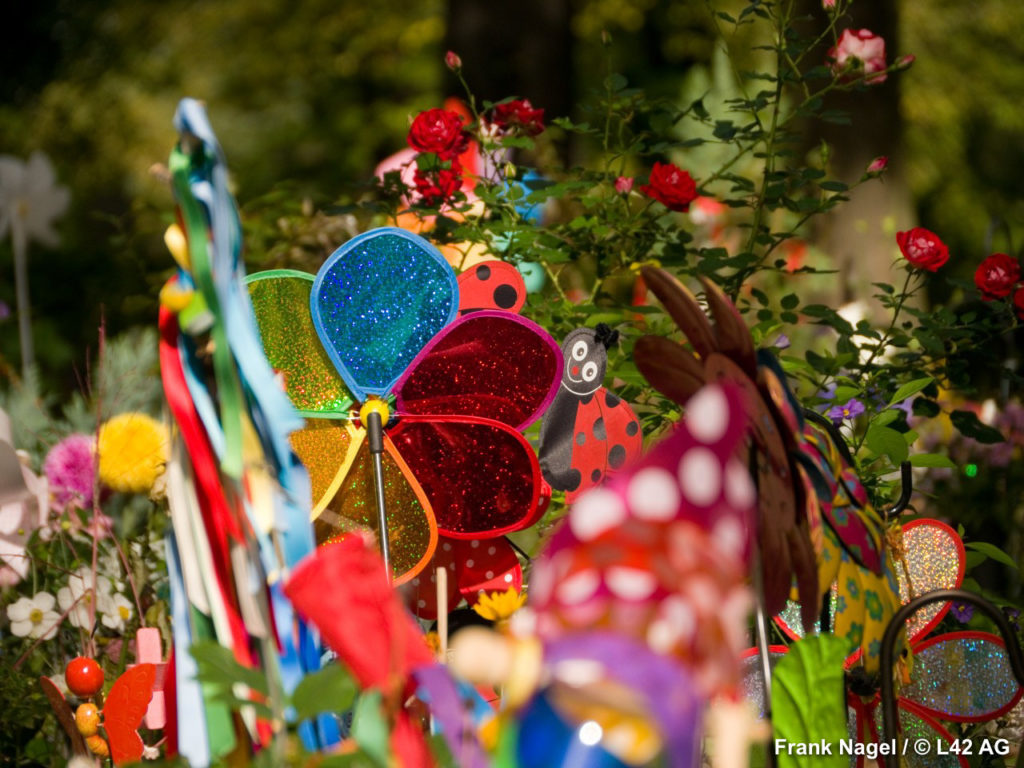
Let us get up again and go to see the tomb – once considered “of honor” but now no longer – of the educator Adolf Diesterweg at I-S-002 with its smiling bust and happily bald head and sideburns left to the wind. The tomb consists of a small garden full of flowers and enclosed by a iron, chain-link fence from which hang numerous medals in the form of stars. The important scholar was born at the end of the 18th century and thus before the positivist era, before, that is, learning was rigorously separated into humanistic and scientific camps. Therefore, he studied everything: nature, mathematics, history, philosophy, and, finally, pedagogy. He founded the first Pestalozzi school in Berlin and fought for the creation of a secular curriculum in a time in which schools were almost exclusively religiously oriented. Because of his revolutionary ideas he was first suspended and then sent into early retirement. It was then that he began to write instructional books for teachers of mathematics, geometry, and languages. What is disturbing is that his tomb is no longer considered “honorable”. We can only hope that it is not an ominous sign of the capital’s state of education.
A Tomb of Honor, however, has been kept at S-N-002 for the 19th century writer David Kalisch.
The stone at K-010-007 is dedicated to the author Hedwig Dohm who lived between the 19th and early 20th centuries. “Human rights have no gender” reads the inscription below the transparent red arch that runs across the top of the uterus-shaped tomb. This stone was donated in 2007 by the Union of German Female Journalists in honor of Frau Dohm’s courageous battle for women’s rights.
At 103 is the other half of the heart-wrenching garden of the star children. Dedicated to those who were given a little time to play here on earth, a wooden boat a few meters long. The main tree is in the form of a cross with branches that are a bit crooked from which hangs a sailor’s rope which has been happily decorated with just about everything. The miniscule tombs have been decorated with marbles, little machines, dolphins, colored stones, lit candles, sunflowers, dragons, little red hearts, and lots of butterflies in a crescendo of happiness and incomparable sadness. There is even a little pond of about twenty centimeters in diameter into which a little wooden frog is about to dive. The two plots dedicated to the children was strongly fought for by the association of volunteers together with the support of the charismatic owner of Café Finovo.
We now find ourselves before E-SE-001 where another important doctor rests. Dr. Friedrich Frerichs lived through the middle of the 19th century, in the time of great enthusiasm for new scientific methods of clinical research. In those years both physics and chemistry became instruments of pathological research. Dr. Frerichs was concerned with metabolic dysfunctions, and discovered leucine and tyrocine in urine. He is responsible for founding the German Society of Internal Medicine.
The tomb of honor at Number 109 is in the memory of the famous surgeon Dr. Bernhard von Langenbeck, founder of the German Society of Surgery. “St. Matthew’s, or the afterlife of the Charité,” the poet mutters. Many instruments and surgical procedures invented by the doctor still carry his name today.
Let’s leave the afterlife of the Charité behind us and move on to tombs E-S-001 e E-S-008, dedicated to the early 20th century historian Erich Caspar and the politician August von der Heydt, a Prussian of great success and energy as well as strategist of finance. His dark granite stone rests upon a pedestal of four steps.
Stone E-001-006, however, is entirely different. A late-classicist tomb in clear marble crowned by a charming acroterion, it memorializes the 19th century musician Louis Wandelt.
The jagged stone K-O-020 recounts a different history, and a different century. Herr Kamieth was the director of the (no longer existing) Potsdamer station of West Berlin. A police inspector beat him up in November of 1951 after having found communist propaganda in the station offices. Later, Herr Kamieth died of a concussion. The cause of his death became the object of months of tension and discussion between the two Berlins until the criminal court of West Berlin found the police inspector guilty.
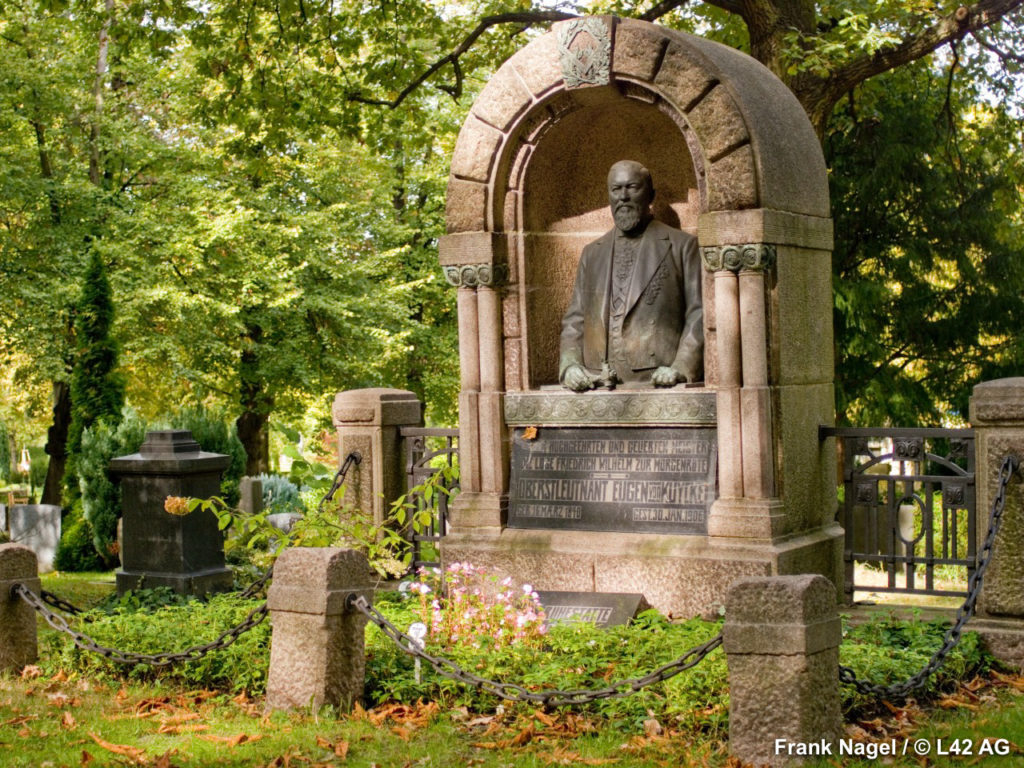
At C-010-005 we take a step back about half a century to met the enigmatic crypt of a Masonic lodge chief, Eugen von Kuycke, who is represented by a powerful and bearded half-bust, dressed in a mantle, sumptuously spruced up with all the chrisms of the rites of the lodge: square ruler, compass, hammer, crosses, and stars all over the place. A lieutenant colonel by profession and a powerful mason by vocation, venerable of the Frederick Wilhelm of Aurora Lodge, he was known, among other things, for his temperament and his savoir-faire. It is said that in 1902 he resolved the annoying inconvenience of his son’s unsuitable marriage proposal by having him shut up in an asylum. Nevertheless, it seems as if the feisty youth managed to escape his father’s punishment. The poet brings his hands to his chest, raises his eyes skyward, and says “Ah, l’Amour!”
The statue of the powerful maestro, together with others, was recently smuggled out of the cemetery but, heavy as it was, was immediately recovered. We are eagerly awaiting the return of his colleagues.
At the Tomb of Honor C-W-016 to Herr Bock, founder of the music publishing house of the same name, we finish up our eastern walk.
Now we must get ready to discover the western side of the cemetery and with it our third walk. If we began our tour in the east at the tomb of Walterchen of the heart of gold, here in the west we shall begin at the roundish at X4-001-009, placed in memory of the multifaceted Frau Helga Goetze, author, artist, and political activist, dedicated, above all, to the battle for sexual freedom. More than anything, she is often remembered for her unambiguous, if a bit inelegant, phrase “Ficken ist Frieden” – “Fucking is Freedom” – a slogan she long carried almost daily upon a billboard before the cafeteria of the Technical University or the Kaiser Wilhelm Gedächtnis Kirche.
Her neighbor Jürgen Balgida at X3-W-005 was a young, extremely inspired neo-Realist photographer who also died of complications related to AIDS.
Walking onward about a hundred meters we turn back in time about a hundred years with the Tomb of Honor at D-O-035 in memory of the sculptor Friedrich Drake, the one who was responsible for the famous statue of Victory gracing the top of the column the Germans call the Siegessäule and of the statue of Frederick Wilhelm III, which is in the Tiergarten.
Further ahead at D-S-024 we meet the oldest tomb in the cemetery. It consists of a Gothic cross with angels and allegorical figures symbolizing the arts and sciences, probably a description of the deceased’s activities. It is the work of the sculptor August Julius Streichenberg and was finished in 1858.
The bones of the theologian Immanuel Hegel, son of the famous philosopher, are at D-S-008.
A lovely cross at F-N-024 symbolizes the son of the wealthy Jewish banker Golson Schlesinger’s conversion to Protestantism in 1817. The young man also changed his surname and became Stahl. He studied the philosophy of law, became a professor, and began to be interested in canonical law, publishing a series of books on the theme of the organization of the monarchical state as the expression of the principle of divine Christian order.
The poet sighs.
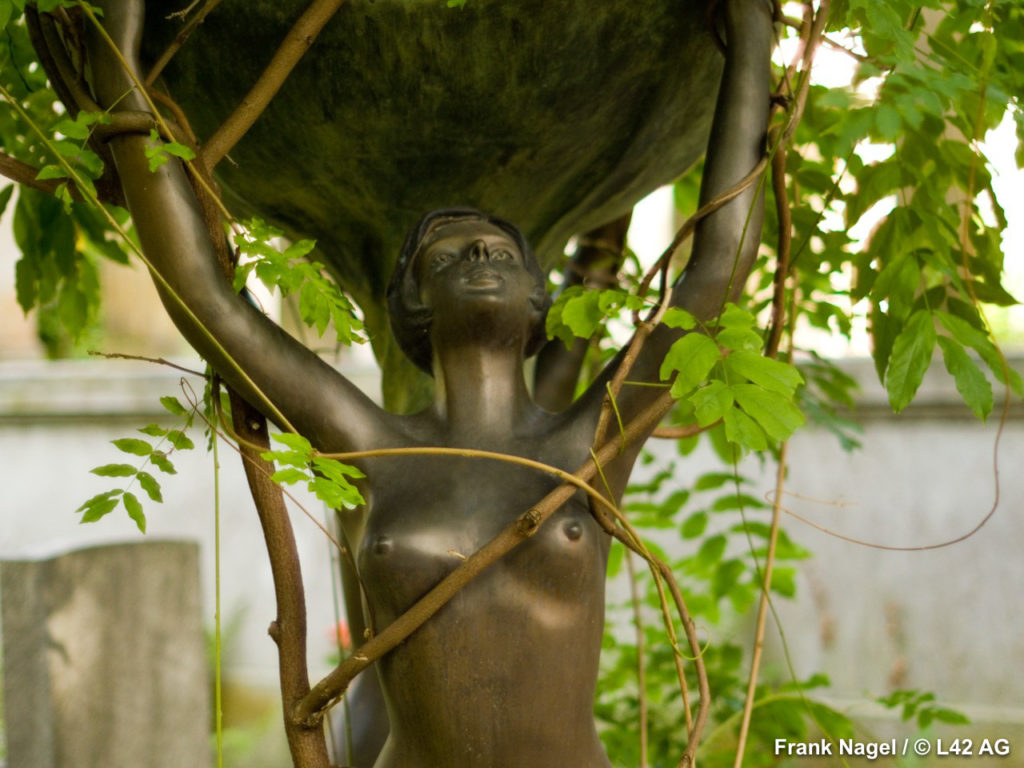
The tomb F-001-008 in memory of Frau Euler-Hochhuth, who died just a few years ago, is most certainly an attractive one. Two feminine statues support a similarly feminine font upon which the following words are written: “The eternal feminine attracts us.”
The poet sighs again.
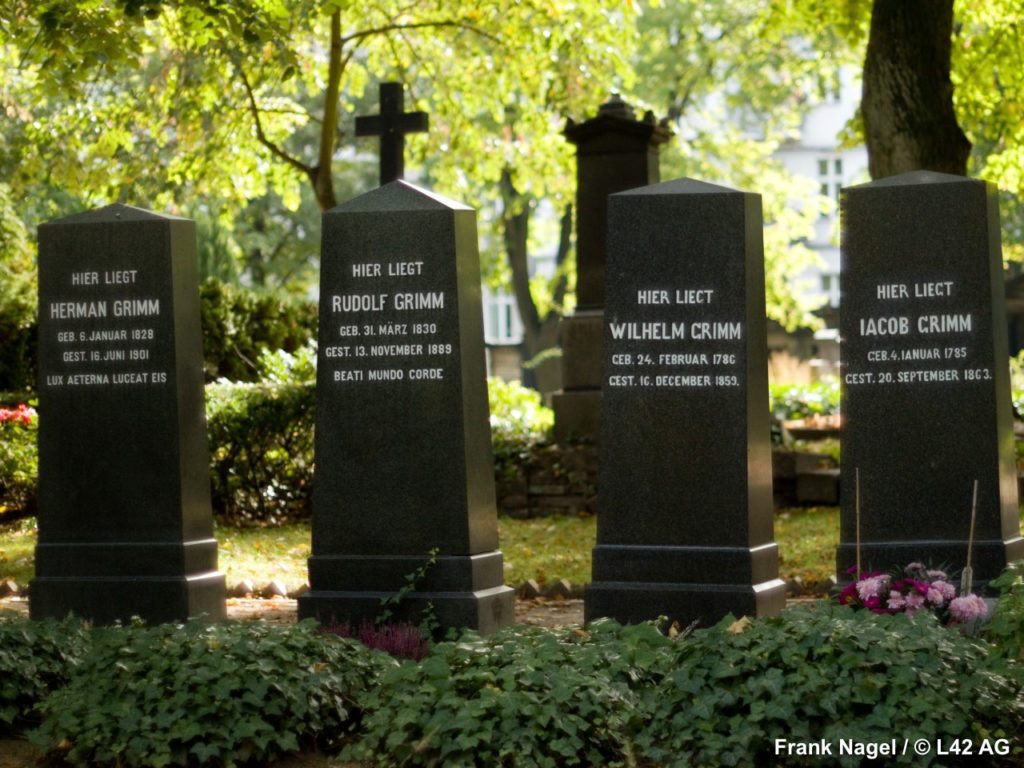
Just a few more steps and we arrive at the simple Tombs of Honor F-S-001 erected to the memory of the Grimm Brothers, Jacob and Wilhelm, and to Wilhelm’s sons. In the 19th century the famous Grimm Brothers collected German sagas, fables, and ancient poems and myths in accordance with a fertile romantic spirit and are as a consequence considered the fathers of German Studies. They not only wrote fables for children – which, in the end, aren’t really all that suitable for children all of the time – but also books on grammar and even part of the German dictionary which was to be published only in 1961. Jacob concerned himself with the letters a, b, c, and f up to the word “Frucht” (fruit), while Wilhelm worked on the letter d.
The poet pulls his little book yet again from out of his pocket and, finally, with a frightful sneer, shows it to us. It is The True Story of Hänsel e Gretel, the one we saw inside Café Finovo. The poet smuggled it away! “Borrowed it,” he corrects us.
And now we shall approach the largest tomb of the entire cemetery, a true court, circumscribed by Ionic columns erected at the end of the 19th century which host an impressive mausoleum from the very first years of the 20th century. This imposing structure tagged as F-S-008 (and restored by the Deutsche Bank) was erected in memory of the liberal banker Adolph vn Hansemann, who lived in the first half of the 19th century. He was responsible for founding the Diskonto Gesellschaft in Berlin in 1849, a large modern bank which was to become one of the most powerful in Germany and which in 1929 was to become part of the Deutsche Bank. Pushing open the heavy bronze gate we enter into a little garden where we are met by benches, amphora, hortensias, lovely smelling roses, and the worried glance on the bust of the banker and minister of Prussian finances.
The same time period goes for the Tomb of Honor for the chemist Eilhard Mitscherlich who discovered phosphor probe, also known as Mitscherlich probe, in addition to the isomorphism of crystals and the polymorphism of chemical binds. This celebrated chemist, who was born in 1794, also studied philosophy, ancient languages, and medicine and was the dean of the university.
Next to such a scientist at number F-SE-D we find the resting place of a 19th century court chef, Herr Schwimmer, who, judging by the mausoleum, must have been divine.
The tomb has been marvelously restored by its new sponsor.
The poet confesses that he too has been wandering around to find a tomb to adopt, but when we ask him how he intends to come up with the amount to become a sponsor, something that starts at two thousand euros, he responds that memory is important and that just the very possibility of being able to contribute to culture makes him feels very honored indeed. That fact that it is easier for a camel to go through the eye of a needle than for a poet to have good business sense is something that’s been more or less a given for a long time. But having a look at www.efev-ev.de, the digital non plus ultra excellently run by the cemetery, and walking through these avenues really does awaken the desire to participate in protecting our historical and artistic heritage and this idea of wealth, naturally, does not escape the poet whatsoever.
Next we find ourselves at the aged tomb F-WE-030 which since the year 2000 has been part of the ecumenical project Kirche PositHIV – the positive church – of the association Denkmal PositHIV – positive monument – which in German is a play on words “think about it” and the locution “monument to memory” and the adjective “positive”, naturally, stands for HIV positive.
Next, at the former Tomb of Honor P-4-009, we come to the limestone statue with the inclined head in memory of the German-Polish composer and piano virtuoso Xaver Scharwenka who died in the 1920s.
The Tomb of Honor at P-W-023 belongs to one of the founders of mathematical physics, Gustav Robert Kirchhoff.
Following one after the other are the Honorary Graves to the historian Georg Waitz at P-N-016, author in the middle of the 19th century of a colossal work on German history in eight volumes; that of the Austrian Germanicist Wilhelm Scherer at F-WE-020; and then the historian Heinrich von Treitschke at Q-O-016. Finally, we arrive at the square stone Q-008-022 of the maestro and composer Max Bruch, famous for his symphonies and his violin concertos.
We are now before the dark stone at Q-008-022 in memory to the Jewish family Morgenstern which fell victim to the Nazis.
The Honorary Grave Q-O-047 remembers the courageous Frau Minna Cauer, a publicist and pacifist activist during the First World War who fought for women’s rights.
We shall conclude this third tour with two recent tombs: that of the German-Ghanaian writer May Ayim Opitz at Q-017-017 and that of Dr. Cord Schauenburg at Q-021-024, a trusted doctor of many people suffering from AIDS.
And we shall leave just as we arrived, through the monumental stone gate. The poet, however, lingers behind, never satisfied, to take one last walk.
If that which these bodies were has undoubtedly left us, in honor to humanity their stories and spirits remain together with their passions, raised up into the air by the wind which blows only to be brought back down to earth and mixed back into our new stories and passions, which seem so very actual but which too shall be dissolved into air only to be brought back down and forever onward as long as there is wind and as long as there are stories…
( Translated by Alexander Booth )

